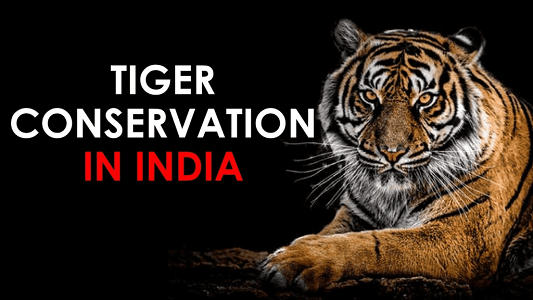
State of the Ungulates and Tiger Conservation – CLAT 2026 Insight
Introduction
A comprehensive assessment of India’s ungulate population has revealed a concerning trend of declining hoofed mammals in several forest zones. Ungulates such as chital, sambar, nilgai, and gaur form the backbone of India’s carnivore food web, especially for top predators like the tiger.
As India’s conservation policies evolve under increasing human pressure, the interdependence between prey and predator is coming under sharper focus. For CLAT 2026 aspirants, this represents a critical intersection of wildlife law, habitat protection, biodiversity, and human-wildlife conflict.
Why in News
– The National Tiger Conservation Authority (NTCA) and Wildlife Institute of India (WII) released prey density data from the All-India Tiger Estimation 2022.
– The report shows that prey species populations are declining in many tiger habitats due to habitat loss, fragmentation, and human encroachment.
– This impacts tiger survival and increases instances of human-wildlife conflict.
Point-Wise Summary
- **What are Ungulates?**
– Hoofed herbivorous mammals like chital, sambar, nilgai, gaur, antelope, and wild pigs.
– Core prey base for tigers and leopards in India.
2. **Key Findings from the Assessment:**
– Populations declining in Odisha, Jharkhand, Chhattisgarh due to habitat fragmentation and human pressures.
– Forests in Uttarakhand, Western Ghats, and Northeast show higher stability in prey populations.
3. **Habitat Influence:**
– Prey density is higher in protected forests and national parks.
– Fragmented, degraded, and urbanized landscapes show lowest ungulate survival.
4. **Regional Trends:**
– Chital is the most abundant prey in most forests.
– Sambar remains stable in Central India and Western Ghats.
– Gaur and wild pig populations vary based on terrain and human interface.
5. **Threats Identified:**
– Deforestation, development projects, poaching, livestock competition, and human-animal conflict.
– Conversion of grasslands and wetlands into agriculture or urban settlements.
6. **Impact on Tigers:**
– Decline in prey pushes tigers to hunt livestock, increasing conflict.
– Prey availability directly linked to carrying capacity of tiger reserves.
Explanation of Key Terms (Notes)
– **Ungulates**: Hoofed animals that graze in forests and grasslands.
– **Chital/Sambar/Gaur/Nilgai**: Major Indian herbivores forming prey base for tigers.
– **Carrying Capacity**: Maximum number of tigers an ecosystem can support based on prey density.
– **Habitat Fragmentation**: Splitting of natural habitats due to human activity, making them unsuitable for wildlife.
– **Human-Wildlife Conflict**: Clashes between animals and humans due to shrinking natural spaces.
– **Ecological Balance**: Natural equilibrium between different species in an ecosystem.
Relevance for CLAT 2026 Aspirants
– Wildlife conservation laws and policies under the Wildlife Protection Act, 1972.
– Legal mechanisms around habitat protection and biodiversity under Articles 48A and 51A(g) of the Constitution.
– Case law on forest rights and indigenous community protection.
– Environmental impact assessment and sustainable development practices.
– Current Affairs 2026 topics focusing on environment and governance.
Conclusion
The survival of tigers in India is intricately tied to the well-being of their prey species. Without adequate conservation of ungulates, predator populations will continue to decline or migrate into human settlements. For CLAT 2026 aspirants, this issue exemplifies how ecology, law, and policy interact in addressing one of India’s most pressing environmental challenges.




